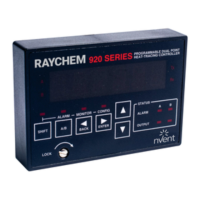31 / 82
EN- Raychem920series-IM-H5687405/15
INDUSTRIAL HEAT TRACING SOLUTIONS
• ThisalarmmustbeenabledanditssetpointmustbebelowtheCONTROLSETPOINT
temperature if fail-safe mode uses the temperature from TS 1.
3.7.3 HIGH TEMPERATURE SENSOR 1 ALARM
Purpose: If enabled, the HIGH TS 1 ALARM allows for alarming of high temperature conditions as
sensed by the first temperature sensor (TS 1).
Alarm Mask: ENABLE or DISABLE
Range: –76°F to 1058°F (–60°C to 570°CF)
Procedure: Adjust the HIGH TS 1 ALARM temperature setpoint to the desired value. Note that the
HIGH TS 1 ALARM must be enabled in order to adjust the HIGH TS 1 ALARM temperature setpoint
unless the TS 1 HIGH LIMIT CUTOUT feature is enabled.
IMPORTANT: This alarm should only be used for applications involving a product that is sensitive
to over temperature. General use may result in nuisance alarms due to the outflow of hot product
or steam. This may be a case where the alarm should be enabled and nonlatching temperature
alarming used. A high temperature condition resulting from a forced on failure of the heating
circuit should first be alarmed by the SWITCH FAILURE ALARM. See section 3.8.18 on page 40 for
more information.
3.7.4 TEMPERATURE SENSOR 2 FAILURE ALARM
Purpose: Enabling TS 2 FAILURE provides indication of an open or shorted failure of TS 2.
Alarm Mask: ENABLE or DISABLE
Procedure: Enable or disable alarming of a failed second temperature sensor (TS 2) as required.
IMPORTANT:
• Ifnosecondsensorisinstalled,disablethisalarm.Thisfailurealarmshouldbeenabledifa
second temperature sensor is connected to the TS 2 input.
• Thisalarmisalwayslatchedandmustberesetbytheuser.
3.7.5 LOW TEMPERATURE SENSOR 2 ALARM
Purpose: If enabled, the LOW TS 2 ALARM allows for alarming of low temperature conditions as
sensed by the second temperature sensor (TS 2).
Alarm Mask: ENABLE or DISABLE
Range: –76°F to 1058°F (–60°C to 570°C)
Procedure: Adjust LOW TS 2 ALARM temperature setpoint to the desired value. Note that the LOW
TS 2 ALARM must be enabled in order to adjust the LOW TS 2 ALARM temperature setpoint.
IMPORTANT:
• Ifnosecondsensorisinstalled,thisalarmshouldbedisabled.Thisalarmshouldbeenabled
and the setpoint should be appropriate for the heating application. Maintaining a minimum
5°C differential between low temperature alarming and the CONTROL SETPOINT temperature
minimizes nuisance alarming due to momentary dips in temperature. Another alternative to
this is to configure the controller for non-latching temperature alarms.
• ThisalarmmustbeenabledanditssetpointmustbebelowtheCONTROLSETPOINT
temperature if fail-safe mode uses the temperature from TS 2.
3.7.6 HIGH TEMPERATURE SENSOR 2 ALARM
Purpose: If enabled, the HIGH TS 2 ALARM allows for alarming of high temperature conditions as
sensed by the second temperature sensor (TS 2).
Alarm Mask: ENABLE or DISABLE
Range: –76°F to 1058°F (–60°C to 570°C)
Procedure: Adjust the HIGH TS 2 ALARM temperature setpoint to the desired value. Note that the
HIGH TS 2 ALARM must be enabled in order to adjust the HIGH TS 2 ALARM temperature setpoint
unless the TS 2 HIGH LIMIT CUTOUT feature is enabled.
IMPORTANT: If no second sensor is installed, disable this alarm. This alarm may be used for
applications where a product that is sensitive to over temperature is involved. General usage could
result in nuisance alarms due to the flow of hot product or steam out. This may be a case where
the alarm could be enabled and non-latching temperature alarming used. A high temperature

